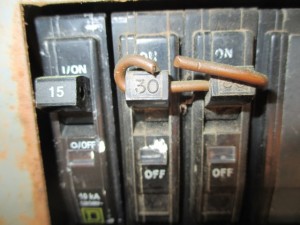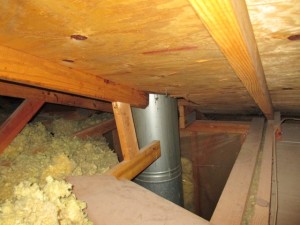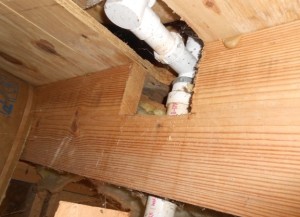I went almost two months without posting any new articles to my blog. I think the reason for this is time and not knowing what to talk about. I mean there are thousands of issues that I could write about, but it’s difficult to think of things that I can write entire articles about. So I think I came up with a great solution! Every week I’m going to try to write a post about some of the issues I’ve seen during my inspections that week.
So lets jump into it. The first issue is a man-made double pole breaker.
 The picture on the left is a proper double pole breaker and the one on the right is a man-made double pole. Double pole breakers have handles that are connected during manufacturing. This allows both legs of the circuit to trip simultaneously if either side has a short. They are used as safety devices to protect the wiring of the circuit from drawing too much power. It’s critical that they trip at the same time.
The picture on the left is a proper double pole breaker and the one on the right is a man-made double pole. Double pole breakers have handles that are connected during manufacturing. This allows both legs of the circuit to trip simultaneously if either side has a short. They are used as safety devices to protect the wiring of the circuit from drawing too much power. It’s critical that they trip at the same time.
The picture on the right is a DIY double pole breaker. You’d be surprised how often I see this. One thing I’ve never been able to figure out is why and how does someone do this? I mean for $10 you can buy an actual Double Pole breaker. I mean to make your own you would have to find a nail with a similar diameter as your two holes and bend that nail (while attached to the two breakers) witho ut breaking the breakers themselves. I mean I’m handy guy, but I can’t quite figure out how to do this or even why someone would want to. This would take me at least an hour and I’d probably break a few breakers trying to get it right. It seams like spending $10 at Home Depot would be the quicker and safer option. This is what makes my job so fun!
ut breaking the breakers themselves. I mean I’m handy guy, but I can’t quite figure out how to do this or even why someone would want to. This would take me at least an hour and I’d probably break a few breakers trying to get it right. It seams like spending $10 at Home Depot would be the quicker and safer option. This is what makes my job so fun!
Another issue I saw this week was a truss that had been cut to allow for a vent above the stove. The problem here is that trusses are engineered wood members and can NEVER be modified in the field like this. Actually, I wouldn’t call this a modification since they didn’t even try to support the truss that they cut.
I saw this week was a truss that had been cut to allow for a vent above the stove. The problem here is that trusses are engineered wood members and can NEVER be modified in the field like this. Actually, I wouldn’t call this a modification since they didn’t even try to support the truss that they cut.
Here’s another photo of a cut wood I took this week. This one is actually a cut floor joist. All wood members have pretty strict guidelines as to how much you can notch or drill out of a piece of wood, and where those notches and holes are allowed to be made. For this floor joist the maximum notch allowed is 1/6 the depth of the member (1/3 for notch width). Since a 2×10 has a depth of 9.25”, you are only allowed to notch is 1.5” deep and 3” wide. As you can see from this picture this is notched about 50%. This is WAY beyond what is allowed and notching a member this much drastically reduces the strength of the floor system.
the member (1/3 for notch width). Since a 2×10 has a depth of 9.25”, you are only allowed to notch is 1.5” deep and 3” wide. As you can see from this picture this is notched about 50%. This is WAY beyond what is allowed and notching a member this much drastically reduces the strength of the floor system.
I was going to go through a bunch of photos I found this week, but this post is already getting long. I think I’ll call it a night here and write another post tomorrow about the other cool stuff I found this week. Stay Tuned!
Be Happy and Be Kind!
T.J. Thorne





